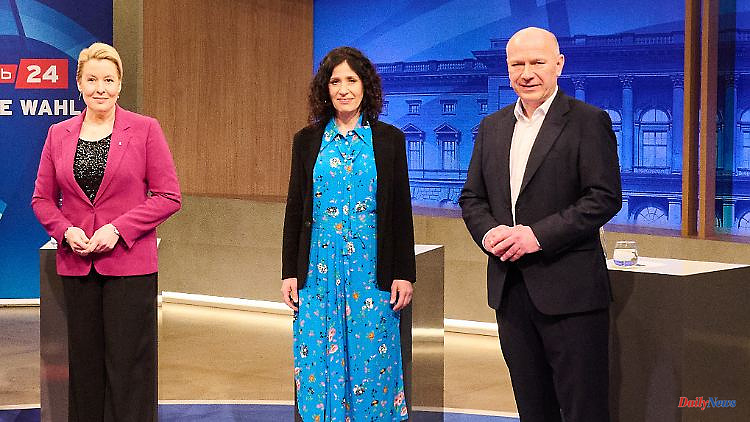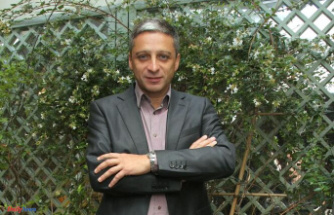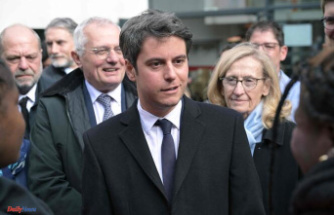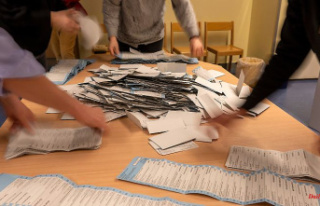Wegner, Giffey or even Jarasch? The day after the repetition of the House of Representatives elections, it is completely unclear who will govern the capital with whom in the future. One thing is certain: the winner of the election, the CDU, does not have it in his hands to appoint the governing mayor in the future.
The bittersweet election victory of CDU top candidate Kai Wegner did not taste any better the morning after the sensational result of 28.2 percent. At least not for the Berlin Christian Democrats, who do not have the formation of a Berlin Senate led by Wegner in their own hands. In three out of five conceivable scenarios for forming a government, the CDU provides the new governing mayor. But the fact that the Red City Hall falls into black hands is not the most likely option.
1. Is Jarasch still second?
The conceivably narrow 105-vote lead of the SPD over the Greens brings with it a great deal of imponderability. By the end of the week, state returning officer Stephan Bröchler wants to decide on a recount in view of the close result. After that, the SPD lead could be greater or be gone altogether. If the latter happens, the Greens themselves will claim to lead a government coalition with the SPD and the Left Party in the future. It is questionable whether the SPD under Giffey would agree to this. As a junior partner of the CDU, she would have the prospect of more posts, more of her own positions in the coalition agreement, and the Governing Mayor Franziska Giffey flirted with partners other than the Left Party and the Greens during the election campaign anyway.
On the other hand, Giffey's position in the Berlin SPD - she is not only head of government, but also co-chair of the party - is in acute jeopardy if the SPD slips to third place and thus definitely loses the Red City Hall. How an SPD would position itself after Giffey, for a junior role under the CDU or the Greens, is completely open.
2. Will the grand coalition come back?
In the past decades it was one of the most common government constellations, now it is no longer practiced either in the federal government or in one of the 16 federal states: the grand coalition of CDU and SPD. The election result could pave the way for a comeback for the supposed obsolete model. Kai Wegner needs a coalition partner if he finally wants to become Governing Mayor for the third time. He would probably be willing to make big concessions for that. Most of the content overlaps are still with the SPD.
Giffey supports the further construction of the A100 federal motorway through the city and, like Wegner, rejects the expropriation of housing groups, which a referendum has obliged the Senate to do. The CDU must make cooperation as palatable as possible for the SPD so that they don't simply continue with red-green-red. That could most likely happen if the Social Democrats slip down to third place, but even then it is not mandatory.
3. Will black and green rule for the first time?
Hamburg and Hesse have shown the way: Under certain circumstances, the Greens can also make themselves a junior partner of the CDU. But that requires a great deal of willingness to compromise on both sides. Wegner's trump card: After the Greens are almost level with the SPD, Jarasch called for a continuation of Red-Green-Red to be treated as equals. The relationship between Jarasch and Giffey is distant. Giffey also tends to be very clear about who is the governing mayor and who is a senator.
If the SPD does not accommodate the Greens, the flirt with the CDU would at least be a means of pressure for the Greens. But not a particularly credible one: Both Wegner and Jarasch made it clear before and after the election that they did not intend to adapt their transport policy to the other side. The CDU wants to give car traffic priority again in the city, the Greens want to gradually drive cars out of the city by making driving less and less attractive. A compromise on this question alone is actually only conceivable after the consumption of certain substances from Görlitzer Park. When it comes to housing, security and migration, too, there really isn't a match between black and green.
4. The "coalition of losers" continues
The SPD, Greens and Left Party collected 247,458 fewer votes than a year and a half ago on Sunday, while the CDU gained 99,513 votes and is now around ten percentage points ahead of the SPD and Greens. The fact that Giffey's Senate was voted out, as CDU politicians have been speaking into every microphone since the evening, seems to be proven by these figures. Nonetheless, together the parties continue to have a stable majority, and they have only just begun to govern. Now they could bring the five-year legislative period to an end and work through the coalition agreement. In the absence of alternatives, the left wants to continue anyway.
For Giffey, red-green-red is the only option not to clear out her desk in the Red Town Hall after 13 months. And the Greens - regardless of whether they placed second or third - would probably have difficulty explaining to their own members how greener politics should be possible with the CDU than with the SPD and the Left. CDU General Secretary Mario Czaja can still appeal to the "decency" of the three parties on ntv and warn against a "coalition of losers": It is very much a case of a continuation of the alliance. Even if Giffey and the SPD will not have it any easier with the powerful districts that they have lost in rows to the CDU, Greens and AfD.
5. Kenya: the very grand coalition
The most improbable of all options stems from the realms of arithmetic and fantasy, but it is well worth considering. In the five-party parliament, the three forces of the political center - CDU, SPD and Greens - come together to 75 percent. They would thus have a constituent majority and could sever Gordian knots in Berlin's perpetual reforms, especially when it came to reorganizing the responsibilities of the city and districts. Lorenz Maroldt, the editor-in-chief of the Berlin newspaper Tagesspiegel, also suggests this. All other coalition options lack the necessary strength and also the time, given the legislative period of only three and a half years.
"Such a coalition would be a temporary alliance from the start, with a clear priority to which everything else for the next 36 months is subordinate," writes Maroldt. Berlin can send a real signal of change, strengthen common ground and thus overcome the worryingly bad mood in the city. There is currently zero evidence that it will come to this. However, should the coalition options 1 to 4 listed here fall apart, the historic premiere of a repeat election at state level could produce a second novelty.












